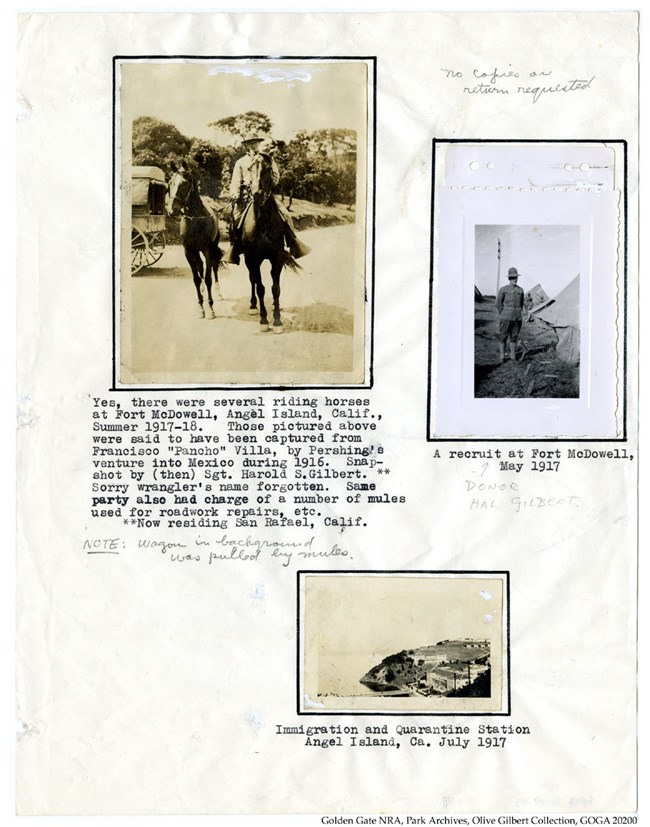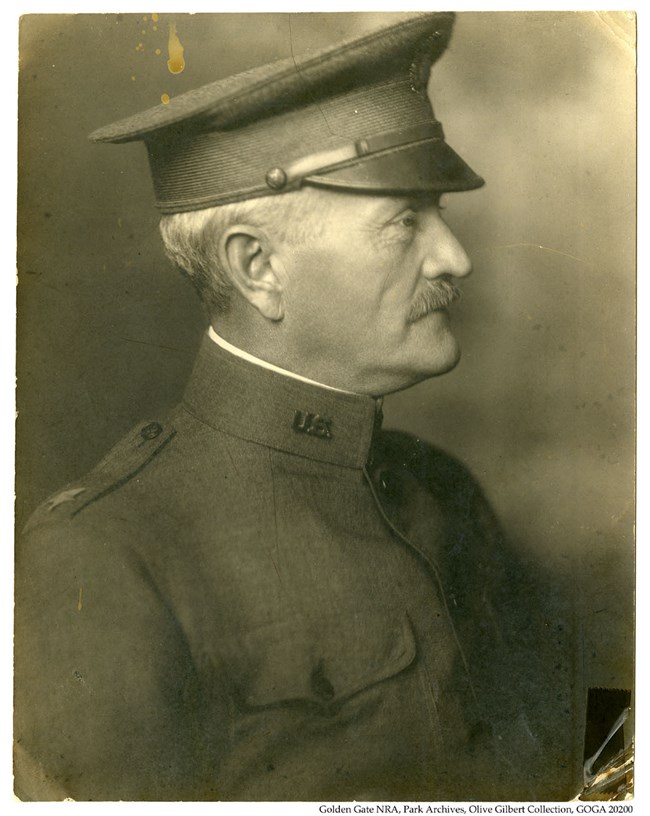
Golden Gate NRA, Park Archives, Olive Gilbert Collection, GOGA 20200.04 
Golden Gate NRA, Park Archives, Olive Gilbert Collection, GOGA 20200.003 Sergeant Harold S. Gilbert served on Fort McDowell, Angel Island in the San Francisco Bay as a young recruit in 1917. In 1909, the Discharge Camp on Angel Island was expanded into a Recruit Depot using a labor force of Army prisoners from Alcatraz Island. During World War I, all men drafted from the western states were processed at this post, in addition to enlisted men returning from Hawaii and the Philippines. In 1922, as troop levels declined after the war, Fort McDowell was downsized into the Overseas Discharge and Replacement Depot, handling men leaving for or returning from oversea posts. One photograph in the collection features two horses allegedly captured by General John J. Pershing from Francisco "Pancho" Villa, leader of populist opposition to the government of Mexico during a civil war. Villa had transformed himself into the Robin Hood of Mexico while with the Constitutionalist Army of Mexico, stealing from rich hacienda owners and robbing trains to pay for the army's expenses. For his success, Villa was awarded with the position of provisional governor of Chihuahua. As his fame grew, he contracted with Hollywood agencies and allowed them to film his raids, printed his own currency, and forced wealthy landowners to pay the salaries of his army. Although the U.S. had consistently validated Villa's campaigns, the U.S. formally recognized the opposing government in 1915 in order to maintain stability in the region. In January of 1916, Villa began to target American interests in Mexico and attacked a train on the Mexico North Western Railway near Chihuahua, killing several American employees. Then, in March, he crossed the border and attacked a detachment of the 13th U.S. Cavalry Regiment in Columbus, New Mexico. In retaliation, President Woodrow Wilson ordered General John J. Pershing and an expeditionary force numbering close to 5,000 men to capture Villa. 
Golden Gate NRa, Park Archives, Olive Gilbert Collection, GOGA 20200.002 John Joseph "Black Jack" Pershing was born on September 13, 1860 in Missouri and graduated from the U.S. Military Academy at West Point in 1886. He was commissioned as Second Lieutenant with the 6th U.S. Cavalry. After participating in Indian campaigns while stationed at various posts, Pershing was assigned as an instructor in military tactics at the University of Nebraska-Lincoln from 1890 to 1895. Then he commanded the 10th Cavalry Regiment and became an instructor at West Point. While teaching at the military academy, he earned the nickname "Black Jack" due to his unpopularity and association with the 10th Cavalry, an all-African American cavalry regiment. After graduating from the Army War College, he was stationed as military ambassador in Tokyo and married Helen Frances Warren, daughter of U.S. Senator Francis E. Warren, in 1905. In 1914, Pershing took command of the 8th Infantry Brigade at the Presidio of San Francisco, but was soon transferred to Fort Bliss, Texas and charged with security along the U.S.-Mexico border. While Pershing was in Texas, his family lived on post at the Presidio. Pershing was making preparations for his family to move to Texas when, on August 27, 1915, his wife Frances and their three children died from smoke inhalation during a house fire started by hot coals which had spilled from the hearth and ignited the highly waxed floor. Only Pershing's five-year-old son survived as he was rescued by the Pershing's long-time orderly. Despite this tragedy, he led the 8th Infantry with distinction during the Mexican Expedition of 1916 under the command of General Frederick Funston. With the outbreak of World War I, Pershing was named Commander of the American Expeditionary Force (AEF) after the sudden death of General Frederick Funston. American success in the war was largely credited to Pershing and he was promoted to General of the Armies of the United States, the highest rank possible for the U.S. Armed forces and a position that was created especially for him. Retiring in 1924, his memoirs won him the Pulitzer Prize for history in 1932. The collection was donated to the Presidio Army Museum from 1974 to 1975 by Olive Gilbert, Sergeant Gilbert's wife. For more information: General John J. Pershing: Angel Island: |
Last updated: February 28, 2015
